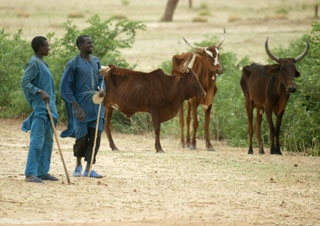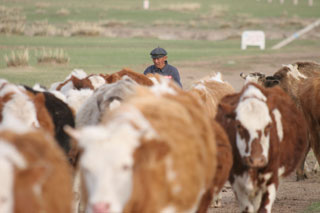Research is identifying new development options that will help pastoral peoples and lands of the South adapt to big and fast changes.
 Over 180 million people in the developing world, especially in dry areas, depend solely on livestock and pastoral systems for their livelihoods. Grassland-based pastoral and agro-pastoral systems are undergoing unprecedented changes that are bringing new opportunities as well as problems. Research is helping to identify new development options for pastoralists that reduce risks and enhance their ability to adapt to changing climates, markets and circumstances.
Over 180 million people in the developing world, especially in dry areas, depend solely on livestock and pastoral systems for their livelihoods. Grassland-based pastoral and agro-pastoral systems are undergoing unprecedented changes that are bringing new opportunities as well as problems. Research is helping to identify new development options for pastoralists that reduce risks and enhance their ability to adapt to changing climates, markets and circumstances.
Pastoral lands are crucial for the production of ecosystem goods and services, for tourism and for mitigating climate change. Pastoral systems can no longer be viewed as livestock enterprises, but as multiple-use systems that have important consequences for the environment and more diversified livelihood strategies.
Opportunities and challenges in tropical rangelands
A new paper, written by scientists at the International Livestock Research Institute (ILRI), describes the major drivers and trends of dryland tropical pastoral and agro-pastoral systems and the challenges they present for development agendas. The paper, entitled Livestock production and poverty alleviation – challenges and opportunities in arid and semi-arid tropical rangeland based systems, gives examples of how research is providing new development options that should make drylands more attractive for public and private investment. The authors urge for a more holistic research agenda that will take into account the socio-economic and ecological synergies and trade-offs inherent in pastoral people taking up new livelihood opportunities.
 ILRI’s director general and lead author of the paper, Carlos Seré, presented the paper at a joint meeting of the International Grasslands and Rangelands Congresses, held 29 June–5 July 2008, in Hohhot, in China’s Inner Mongolia.
ILRI’s director general and lead author of the paper, Carlos Seré, presented the paper at a joint meeting of the International Grasslands and Rangelands Congresses, held 29 June–5 July 2008, in Hohhot, in China’s Inner Mongolia.
Seré says: ‘Perceptions about arid pastoral regions are changing rapidly as we recognize the many functions these ecosystems provide and the new development options available.
‘Pastoralism can no longer be seen as a “tragedy” for common grazing areas but rather as a production system with great potential to sustain complex livelihood strategies.
‘Balancing the needs for increased productivity, environmental protection and improved livelihoods in these fragile drylands will help us address the needs of some of the world’s most vulnerable peoples’.
New development options for pastoral peoples and lands
Much conventional research has focused on increasing the productivity of drylands, for example, by improving livestock and feed management. However, big and fast changes mean that there is a need for an expanded, more integrated, research agenda that investigates what options will work best in given areas and circumstances and how pastoral peoples and lands will benefit.
The new development options need to ease the transitions in pastoral livelihoods that will be necessary in the coming decades and focus on ways to mitigate pastoral risk and encourage adoption of new livelihoods. Poor households may have opportunities to engage in livelihood strategies outside traditional livestock production, such as payments for ecosystem goods and services such as water purification and carbon sequestration. Others may have opportunities to combine livestock keeping with new or increased incomes generated through expanded eco- and wildlife tourism, biofuel production and niche markets for speciality livestock products.
Download Livestock production and poverty alleviation paper and presentation
Livestock production and poverty alleviation, C. Seré et al. June 2008
Reference
C. Seré, A. Ayantunde, A. Duncan, A. Freeman, M. Herrero, S. Tarawali and I. Wright (2008). Livestock production and poverty alleviation – challenges and opportunities in arid and semi-arid tropical rangeland based systems. International Livestock Research Institute, P.O. Box 30709, Nairobi, Kenya.
Impacts from ILRI and partner pastoral research
• Studies in Africa, combining climate change predictions and proxy indicators of vulnerability, identified areas on the continent most vulnerable to climate change.
• Studies in Lesotho, Malawi and Zambia identified economic shocks, drought, livestock losses due to animal diseases, and declining livestock service delivery as major sources of pastoral vulnerability. The study noted marked differences in the ownership of productive assets, livelihood strategies and vulnerability between men and women. This meant that women and female-headed households are still more vulnerable than the general population—and this in spite of the fact that young men are increasingly emigrating from pastoral to urban areas, leaving ever larger numbers of women as heads of pastoral households.
• A participatory pastoral project in East Africa created knowledge and relationships that enabled poor Maasai agro-pastoral communities to influence district and national land-use policies affecting their livelihoods and wildlife-rich landscapes. Locals worked with researchers as community facilitators and played a key role in GIS mapping, representing the interests of their communities to local and national policymakers and delivering the maps and other knowledge products that are helping to protect their wildlife and secure additional income from wildlife tourism.
• Studies in West Africa show that typically it is traders that dictate livestock prices because livestock producers and sellers lack accurate and up-to-date price information. Producers thus have little incentive to increase their livestock production even though a wide range of cross-regional links exist that could greatly increase their market opportunities. This research showed that West Africa’s pastoralists could increase their incomes by entering the growing regional livestock markets if provided with credit for value-added processing, reduced transportation and handling costs, livestock market information systems, and harmonized regional livestock trade policies.
• Other studies have identified that new market opportunities for pastoralists are opening due to increasing demands from affluent members of society. Growing niche markets for certain locally preferred breeds of animals (Sudan desert sheep) or animal products (El Chaco beef), for example, are starting to be exploited in pastoral regions.
Contacts:
Carlos Seré
Director General, ILRI
Email: c.sere@cgiar.org
Telephone: +254 (20) 422 3201/2
